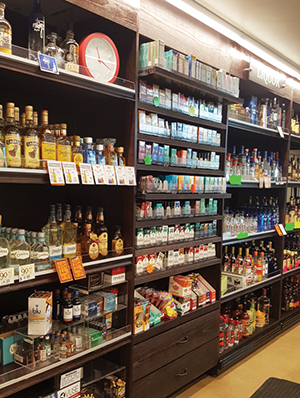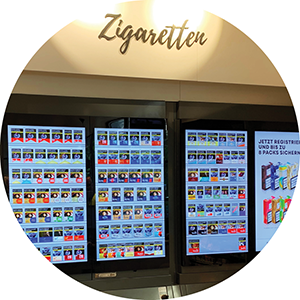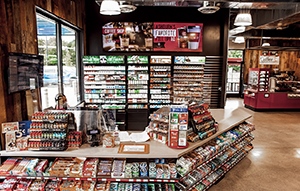 For years, the ubiquitous back bar has displayed tobacco products. Most convenience stores have them, as well as contractual obligations to provide 50% of the available space for Philip Morris products and 35% for Reynolds.
For years, the ubiquitous back bar has displayed tobacco products. Most convenience stores have them, as well as contractual obligations to provide 50% of the available space for Philip Morris products and 35% for Reynolds.
“That leaves 15% of the rest of the fixture for eight to 10 smaller companies,” said Mark Schueller, director of marketing, Premier Manufacturing, the consumer products division of U.S. Tobacco Cooperative Inc. “Distributors are willing to restock, help reorder and update POS. We all want our POS out there.”
Now, new products—vapor, hemp, pouches, e-cigs and more—are joining cigarettes in that space. “Those emerging categories will challenge cigarettes as the number of products increases,” he said.
Often peppered with tobacco marketing materials and federally mandated health warnings, the back bar is feeling extra heat from regulators. In April, the U.S. Food and Drug Administration proposed a controversial ban on menthol cigarettes and flavored cigars, products preferred by an estimated 18.5 million U.S. smokers.
“Menthols are about one-third of all cigarettes sold in the United States,” said Don Stuart, managing partner, Cadent Consulting Group. “They have a flavor profile that is a little less harsh on the throat, and they’re considered to be a gateway to broader smoking. Canada and Europe already ban menthol tobacco.”
Messaging can help [customers] have a good experience quickly.
Over the years, convenience-store retailers relied on major tobacco companies to provide c-stores with no-cost store fixtures, which were then stocked with tobacco products.
“Today, if a store is being built with a lot of space and foresight, retailers put their higher-dollar items in the backbars,” said Sharan Kalva, chief operating officer at C-StoreMaster, a national c-store distributor specializing in tobacco and beverage products.
“They’re not tobacco back bars anymore. They’re controlled retail areas where you sell a variety of products,” said Mike Lawshe, president of Paragon Solutions, a retail design firm in Fort Worth, Texas, “Today, the contracts and offerings are changing. Expensive health and beauty products are coming into that area, and the fixtures are becoming multipurpose. Now, we’ve got everything from Nyquil to Advil to electronics and tobacco on the same fixture. These items aren’t necessarily intertwined, but they’re going into the same space.”
 EMBRACING LED
EMBRACING LED
In 2022, technology impacts almost everything people do, including c-store shopping, and some retailers are exchanging their old-fashioned back bars for LED screens that display digital messages.
Rick Sales is president of Abierto, a digital signage company in York, Maine, that provides electronic signage, such as menu boards, to the convenience industry. Digital signs are frequently used at the back bar, allowing retailers to quickly update tobacco prices from any browser. This is important since prices have been changing about once a quarter for the past few years.
“The way the product is displayed doesn’t change much, but a digital sign provides the back bar with a cleaner, more modern look,” Sales said. “It’s a better experience for the tobacco consumer because it’s easier to read, and the information is in one place. This centralized system allows category managers to ensure that stores meet all the rules [for tobacco retailing] and lets them devote more time to growing the category.”
At the end of the day, the c-store customer “wants to be in the store for less than six minutes,” said Sales. “Messaging can help them have a good experience quickly.”
They’re not tobacco backbars anymore. They’re controlled retail areas where you sell a variety of products.
In Europe, tobacco products are no longer visible in some outlets. Instead, retailers use a digital screen at the back bar, plus technology that automatically dispenses the merchandise to either the store employee or the customer after the customer’s age has been verified and the product is paid for. That technology comes from GM Global Solutions, a Spanish producer of machinery and software for point-of-sale applications.
“It’s a huge step in my opinion,” said Kalva. “It solves many problems, such as theft, shrink and proper management of age-restricted products.”
Digital signage is being used to promote tobacco products—though on a more modest scale—in some U.S. outlets. “These are smaller displays—think of something the size of your phone. Manufacturers use them to focus attention on individual products,” Kalva said. “I don’t think we’ll ever have one big screen where everyone shares the space, especially with the bigger players.”
 Not all c-stores can adopt digital signage, but that doesn’t mean the existing back bar can’t undergo a face lift to make it more attractive to customers. “You can make a dramatic change to the back bar by taking everything out and starting from scratch,” Lawshe said. “Don’t try to squeeze in more things. Re-envision the entire space. Think about what you’d do in a perfect world. The answer to that question will lead to greater sales.”
Not all c-stores can adopt digital signage, but that doesn’t mean the existing back bar can’t undergo a face lift to make it more attractive to customers. “You can make a dramatic change to the back bar by taking everything out and starting from scratch,” Lawshe said. “Don’t try to squeeze in more things. Re-envision the entire space. Think about what you’d do in a perfect world. The answer to that question will lead to greater sales.”
Already, many retailers have increased the frequency of back-bar resets. “It’s not a once-a-year thing anymore,” said Kalva. “I have customers who do it every two or three months, and some do it once a year. Once a quarter is probably adequate. There is a lot of uncertainty now, especially with the regulatory situation. Retailers are being more flexible. They think ‘this is legal now, but I don’t know where that’s going. Until then, I’ll continue to maximize my footprint for operational efficiency.’”
DRESSING UP THE BAR
Marco Company of Fort Worth provides grocery and convenience retailers worldwide with in-store merchandising tools and is often enlisted to refresh the POS area.
“One idea would be to put a new surround around the back bar—wood or laminated—to dress it up,” said Deanna Cooper, vice president of sales, Marco Company. “That would give a clean line around a common wire fixture and give you a top shelf to display other products. Some retailers may put their phone-charging equipment, health and beauty and other items there—items that can’t be out on the floor due to high theft.”
Recently, Marco jazzed up existing back bars by installing stained red oak cabinetry in the space. “It’s like furniture,” Cooper said.
While marijuana laws vary from state to state, industry observers expect cannabis to be legalized nationwide in the future. Owners of CBD dispensaries are researching the best ways to sell those products in-store. “The CBD market has exploded, and [dispensary owners who can legally sell those products] are looking into c-store models,” said Cooper, who has consulted with several operators. “Some want to do a walk-up counter, but none of the products will be visible. Customers will order their purchases through a touchscreen.”
You can make a dramatic change to the back bar by taking everything out and starting from scratch.
The c-store back bar continues to morph. Expect the future fixture to embrace more high-tech enhancements, such as colorful digital messaging, and don’t be surprised if SKUs merchandised there include cellphones and shaving cream. And stores will continue to need an attractive, convenient way to safely merchandise tobacco products and tobacco alternatives.
“Tobacco sales have been eroding for a long time in the U.S., and that will continue at a slow, predictable pace,” said Stuart. “Cigarettes aren’t going to fall off the cliff.”
Back Bar Merchandising

One size does not fit all when it comes to merchandising the back bar. The best planogram depends on your individual store and your customers, experts say.
“Look at what products are providing the best return on your investment,” said Mark Schueller, director of marketing, Premier Manufacturing. “Look at your product mix and your customer base and do the things that are best for your business, not for a suppliers’ business.”
“Some retailers dedicate a section of the back bar to new products, and they reset that section more often than the rest of the back bar,” said Sharon Kalva, chief operating officer at C-StoreMaster. “Retailers should put thought into their product portfolio, new innovative products and what’s selling the most. The more planning that goes into it, the less resets you must do. The retailers who are successful right now are those who are agile, who are keeping up with the latest and greatest products in the category and making sure they’re compliant. Plus, they give consumers options.”
According to NielsenIQ, c-store dollar sales of nicotine pouches increased 470% in the first half of 2020. One brand Kalva recommends is ZYN, a tobacco-free pouch from Swedish Match that comes in several flavors. Swedish Match predicts that sales of ZYN will increase seven times in the next four years, from three million cans sold last year to 23 million in 2025. “They’re the market leader in that segment,” Kalva said. “Customers love the product.”